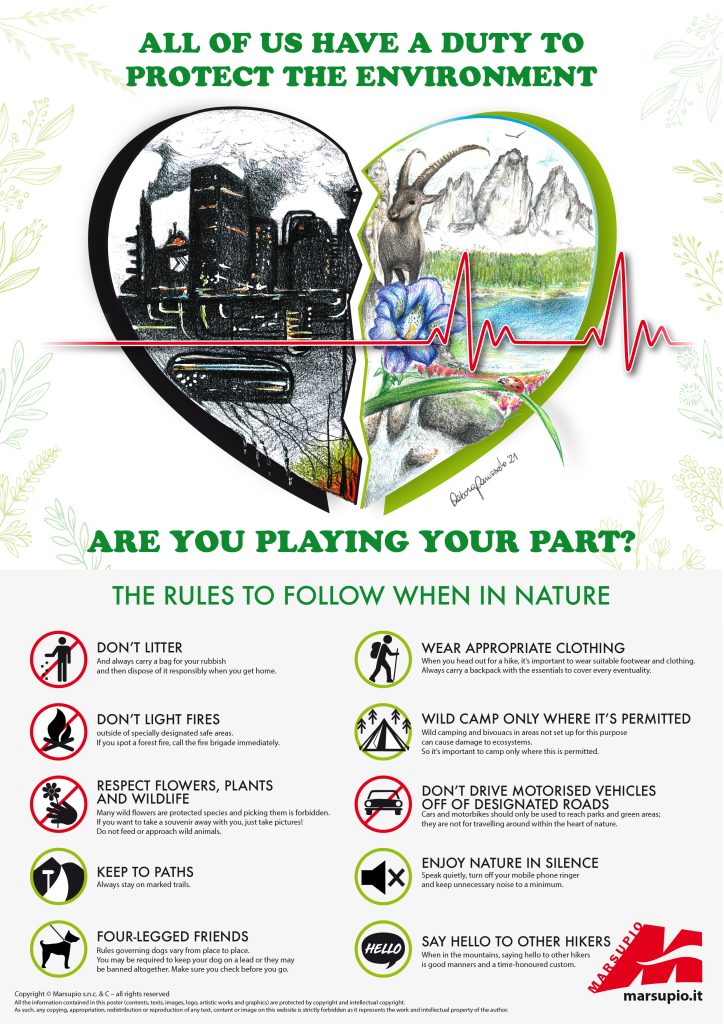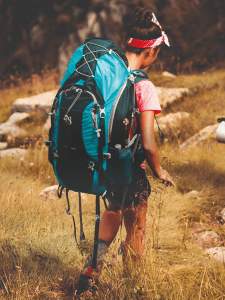With the arrival of summer, the wild areas of our beautiful country are among the most popular destinations for hikers.
So, do you know the rules you should respect to help preserve nature?
On the occasion of the European Day of Parks, which is celebrated on May 24th, we detail below some simple tips to help you enjoy your experience in parks and protected areas.

Don’t litter
And always carry a bag for your rubbish and then recycle it responsibly when you get home.
Bear in mind that a lot of waste isn’t biodegradable: a simple paper handkerchief can take 3 months to break down. And researchers have estimated that face masks can take between 400 and 450 years to break down, while plastic bottles will never completely degrade.
Don’t light fires
Don’t light fires of any kind outside of specially designated safe areas, and be aware that wind can transport stray embers or sparks which could present a fire hazard. Before leaving, make sure you’ve thoroughly extinguished the fire. If you spot a forest fire, move away quickly and call the fire brigade immediately. Wild fires can spread incredibly quickly!
Respect flowers and plants
Every living thing has its own unique role to play in maintaining a balanced ecosystem. Many flowers are protected species and it’s forbidden to pick them. If you want to take a souvenir away with you, take pictures! The same goes for rocks, minerals and fossils: these must be left exactly where you find them. Don’t eat fruit or berries that you don’t recognise as they could be poisonous. Breaking off branches or removing bark from trees can cause severe damage to the tree and is tantamount to an act of vandalism.
Respect wildlife
If you spot an animal, keep your distance as you watch it so that you don’t frighten it. Do not feed or approach wild animals – they could be very dangerous. Also amphibians, reptiles and insects all play a fundamental role in the ecosystem, and must not be disturbed. Never damage nests, dens or anthills – you’re destroying the animals’ homes.
Keep to paths
Always stay on marked path – shortcuts and detours can damage fragile surface soil and cause erosion. What’s more, by doing so there’s a risk you might get lost. Never undertake any outing without first carefully researching the difficulty, length and route you plan to take. And remember, you should never go alone. Don’t cross any fences that could potentially mark the boundary of private property or fields with crops. Be careful of electrified fences surrounding animal pastures; if you need to open one in order to continue on your intended route, make sure you close it securely after you.
You’ll come across a great many stone cairns in the mountains. These are simple piles of stones of various sizes that have been built as waymarkers when official signs are missing or not easy to spot. They’re often present on sections where the path is not clear (such as on scree or rock). It’s important that you don’t alter or knock them down: cairns that are built in the wrong place or are missing altogether can become a real nightmare for hikers and cause them to lose the path and head in completely the wrong direction.
Never throw stones
Children are often fascinated by steep slopes (especially in the mountains) and can be tempted to throw stones to watch them bounce down hillsides. This is extremely dangerous! If you throw a small stone this can dislodge bigger rocks and even boulders and present a serious danger to people or animals below you. This is an absolute no-no.
Dogs
If you decide to take your 4-legged friend with you it’s important to know that rules vary depending on the park or area you’re in. These rules may require dogs to be kept on a leash or they may be banned altogether. It’s worth noting that these regulations are there to protect hikers, wild animals and often also your dog.
Wear Appropriate Clothing
When you head out for a hike, it’s important to wear suitable footwear and clothing. For an easy day hike in the mountains, you need boots that protect your ankles and have soles with a good grip (make sure they’re in good condition before you set off). Long trousers afford protection from scratches, scrapes and dangerous animals (vipers, ticks, etc …). Always carry a backpack with the essentials: plenty of liquids, some high-energy food, a map, a charged phone, a headtorch, sunscreen, a cap, a rain jacket/poncho to protect you from sudden rain showers, warm clothing and perhaps also a change of clothing. Don’t forget to take a first aid kit, which you can stow in the dedicated pocket fitted in our backpacks (visit our dedicated section by clicking here).
Wild camp only where it’s permitted
Wild camping and bivouacs in fragile areas can cause damage to ecosystems. Local flora is particularly vulnerable. So it’s important to camp only where this is permitted or in designated campsites. Furthermore, in Italy, laws relating to wild camping vary from region to region: to avoid getting a fine it’s important to inquire before you set out.
Don’t drive motorised vehicles off of designated roads.
Cars and motorbikes should only be used to reach parks and green areas and not for travelling around within natural areas. Motor vehicles driven across meadows or through woods, or motocross bikes ridden on mountain paths cause major damage to the natural environment: they erode fragile topsoil, pollute the air, scare wildlife, and damage the ground.
Enjoy nature in silence
When travelling in protected areas, parks or nature reserves, try to avoid making loud noises as these can scare local wildlife. Speak quietly, turn off your mobile phone ringer and keep unnecessary noise to a minimum.
Say hello to other hikers
When in the mountains, saying hello to other hikers is good manners; on paths, even the steepest ones, always exchange greetings with other walkers.
If you get caught in a thunderstorm, never take shelter under isolated trees or rocks.
Try to lose altitude first, and avoid any paths equipped with steel cables or metal ladders, and if you’re doing a rock climb just stay put.
If you’re forced to stay out in the open and are unable to quickly reach a safe shelter, move away from any prominent points that rise above the surrounding area, such as tall posts or trees, and in particular never be tempted to seek shelter beneath isolated trees. Also try not to be the highest point in the area around you.
Caves, mountain shelters or hay wains are less secure shelters, but useful in the absence of better alternatives, as long as you stay away from the entrance and walls. Also in this case, try to spread out if you’re in a group.
In case of emergency
All our trekking backpacks are equipped with a special panel detailing useful numbers and instructions on what to do in case of emergency. This can provide invaluable assistance when a crisis occurs.
The key emergency number to remember is 118.
To learn more about this topic, visit the dedicated page of the Corpo Nazionale Soccorso Alpino e Speleologico (The Italian Alpine and Potholing Rescue Service) click here.
To find out about 10 essential tips for organising your next trip to the mountains, click here to read our article.

